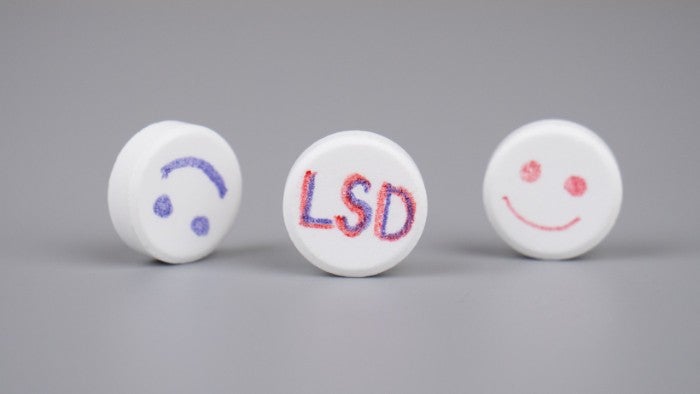

Medically reviewed by Giordano Novak, University of São Paulo on April 3rd 2022
When you’re tripping on LSD, the world feels like a very different place. It can be a wild experience and one that might change your life.
But what if you’re tripping and you want things to stop? Maybe you’re having a bad trip, or you’ve had enough.
Unfortunately, it’s not possible to stop a trip once you’ve started it. You might not be able to halt your acid experience.
Still, you can try to lessen the effects by staying hydrated, calling a sober person you trust, and staying away from unfamiliar places or hazards.
In this guide, we’re going to help you stay safe on your LSD trip. You might not be able to make it stop, but we want to ensure you feel as safe as possible if things don’t quite go the way you want them to.
Lysergic acid diethylamide (LSD) is a very powerful hallucinogenic drug. It’s made from lysergic acid, which is found in ergot, a type of FUNGUS that grows on rye and other grains. LSD has been used for decades to create an altered state of mind.
It is a semisynthetic psychedelic drug that can produce some intense and unpredictable effects, but the way it works has been of INTEREST to scientists, and it has been made part of various randomized controlled clinical trials.
LSD affects the body and brain by interfering with serotonin levels in the brain, which is a neurotransmitter responsible for REGULATING mood, appetite, sleep, and other bodily functions.
It cannot cause drug addiction, and there are no SEVERE adverse effects, but it can negatively impact those with a preexisting mental health condition. This can be worsened if you mix drugs with LSD.
Pro Tip: 400;”>Acid can be taken by placing a drop of it under the tongue or in paper form (called a “blotter”).

An acid trip can feel euphoric and life-changing, and you’ll feel a WIDE RANGE of physical and psychological effects.
Your senses will be heightened, you might see or hear things that aren’t there, and your PERCEPTION of time may be distorted [2].
Some of the things you might experience during an acid trip include:
Pro Tip: Those with existing mental health problems should avoid drug use, especially with LSD, or at least practice extreme caution. It can also cause increased blood pressure, so those with high blood pressure should avoid it.
An LSD high can last anywhere from 6 to 12 hours, but the come down (when your body starts to return back to its normal state) USUALLY lasts around 4-6 hours [1].
The comedown from an LSD trip can last around 4-6 hours, during which time the user may feel depressed, anxious, or confused. It’s IMPORTANT to remember that these feelings are just temporary and that they should pass soon.
The best way to manage a comedown is to get plenty of sleep and eat healthy foods. It’s also important to talk to someone you TRUST about how you’re feeling. If necessary, seek professional help from your doctor or therapist if the feelings persist.
Unfortunately, it’s NOT possible to stop an acid trip once it has begun. However, there are some strategies you can use to make the experience a bit more manageable.
Pro Tip: LSD is not an addictive substance and does not cause physical dependence. However, the tolerance gained through frequent use does leave it open to drug abuse. Always use it with caution and be sensible.
Not every trip is going to be a good one, and that’s why you should ALWAYS be prepared for the worst. If you find yourself on a bad LSD trip, here are some things you can do.
A bad acid trip can be caused by a VARIETY of factors, including taking too much LSD, being in an unfamiliar or uncomfortable setting, and having poor mental health [3].
It’s important to choose your environment wisely before taking LSD, as this can help to reduce the risk of a bad trip. Additionally, it’s important to know your OWN limits and not take too much LSD.
You have to practice CAUTION when you’re buying acid; you can’t just go to the first dealer you find on the street.
Why? Well, the unreputable ones tend to lace their products with chemicals and filler ingredients that can be HARMFUL and even cause poisoning.
This is a method used for cutting costs, helping the dealers maximize profits while the buyers get an impure product.
It’s why we are DEDICATED to ensuring that when you buy acid online, it is only from reputable sources and trustworthy sellers that ensure the LSD is pure.
Check out our recommendation for fantastic LSD products that haven’t been tampered with.
Prior to taking LSD, it is important to educate yourself on the potential effects of the acid trip, the duration, and how to manage the aftermath. Additionally, it is crucial to obtain LSD and other psychedelic drugs from
credible sources to guarantee the best quality. By following these guidelines, you can have a more secure and enjoyable experience. It is worth noting that it is not recommended to smoke LSD.
1: Wacker D, Wang S, McCorvy JD, et al. Crystal Structure of an LSD-Bound Human Serotonin Receptor. Drug Abuse Website. Cell. 2017;168(3):377-389.e12. doi:10.1016/j.cell.2016.12.033
2: Protein structure reveals how LSD affects the brain. National Institutes of Health (NIH). Published February 13, 2017. Accessed December 31, 2022. https://www.nih.gov/news-events/nih-research-matters/protein-structure-reveals-how-lsd-affects-brain
3: Ona G. Inside bad trips: Exploring extra-pharmacological factors. Journal of Psychedelic Studies. 2018;2(1):53-60. doi:10.1556/2054.2018.001
4: Holze, F. (2023, February 1). Lysergic Acid Diethylamide – Assisted Therapy in Patients With Anxiety With and Without a Life-Threatening Illness: A Randomized, Double-Blind, Placebo-Controlled Phase II Study. Biological Psychiatry. Available at: https://www.biologicalpsychiatryjournal.com/article/S0006-3223(22)01553-0/fulltext
Subscribe and get $15 off your next order!
PRISMS LSD CANADA
Please note we have a new etransfer email. Please follow the details at checkout.
Dismiss